Do you have a question about the Miele KFN 12924 SD and is the answer not in the manual?
Details the buttons and displays on the appliance's control panel.
Identifies and labels the various internal components of the refrigerator and freezer.
Instructions for the safe and environmentally friendly disposal of packaging materials.
Guidance on the proper disposal of old appliances to protect health and environment.
General safety advice to prevent injury and damage from improper use or operation.
Specifies the intended domestic use and restrictions for the appliance.
Safety measures and age-appropriate usage guidelines for children.
Details technical safety aspects, including electrical connection and coolant handling.
Provides information about the R600a coolant used in the appliance.
Stresses the importance of correct earthing for electrical safety.
Outlines who is qualified for installation, maintenance, and repair work.
Advises using only genuine Miele spare parts for safety and performance.
Notes on appliance location and maintaining hygiene to prevent infestations.
Safety guidelines for handling frozen food, drinks, and general food items.
Lists items that should not be stored, such as explosive materials or carbonated drinks.
Recommends safe methods for defrosting and avoiding damage to the appliance.
Warnings against using steam cleaners or specific cleaning agents on the appliance.
Specifies the appliance's designed climate ranges and installation environment.
Safety advice to make the door latch unusable before disposing of the old appliance.
Recommendations for installation site to minimize energy consumption.
Guidance on setting temperatures for optimal energy efficiency.
Practical tips on using the appliance to save energy.
Explains how defrosting impacts energy consumption.
Steps to take before the initial use, including removing protective foil and cleaning.
Instructions on how to switch the appliance on and initial cooling process.
Steps for switching the appliance off completely.
How to switch only the refrigerator section off independently.
Instructions for switching off the appliance for extended periods, like holidays.
Recommended temperature for the refrigerator section for optimal food storage.
Recommended temperature for the freezer section for long-term food preservation.
Step-by-step guide on how to set the desired temperatures for each section.
Explanation of the temperature display on the control panel.
Details the adjustable temperature ranges for the refrigerator and freezer sections.
Explains the flashing indicator lights related to temperature settings and alarms.
Explains normal temperature fluctuations and when to investigate potential issues.
Information on how the appliance's warning system is activated and functions.
Details about the temperature alarm, its causes, and indicators.
Explains the door alarm, its trigger condition, and how it stops.
How to manually switch off an alarm before the set temperature is reached.
Explains the purpose of the Super freeze function for rapid freezing.
Identifies situations where the Super freeze function is not required.
Guidance on when and how to switch on the Super freeze function before adding food.
Describes how to switch off the Super freeze function automatically or manually.
Explains the function of Dynamic cooling for even temperature distribution.
Instructions on how to activate the Dynamic cooling feature.
Instructions on how to switch off the Dynamic cooling feature.
Explains the different temperature zones within the refrigerator and how to use them.
Identifies the warmest area and its recommended use for storage.
Identifies the coldest area and its recommended use for delicate foods.
General warnings regarding food storage, including prohibited items and contact with plastic.
Lists foods that are sensitive to cold and should not be stored in the refrigerator.
Discusses the importance of food freshness and minimizing time out of the appliance.
General advice on covering and packaging food to maintain freshness and hygiene.
Tips for storing fruits and vegetables, including gas interactions.
Details how certain fruits and vegetables react to natural gases from others.
Guidance on storing unpackaged meat and vegetables separately for hygiene.
Notes on protein-rich foods that deteriorate faster.
Instructions for storing meat unwrapped to allow air circulation and prevent bacterial growth.
Instructions on how to adjust the height of shelves for different food items.
How to use the split shelf feature to accommodate tall items.
Steps to adjust the position of door shelves and bottle racks.
Information on the appliance's maximum freezing capacity within a 24-hour period.
Explains the importance of freezing fresh food quickly for quality preservation.
Guidance on checking and storing purchased frozen food.
A critical warning against refreezing partially or fully defrosted food.
General advice on freezing fresh food at home.
Lists foods suitable and unsuitable for freezing and blanching tips.
Details suitable and unsuitable packing materials and techniques for freezing.
Steps to take before placing food in the freezer, including using Super freeze.
Guidelines on maximum capacities and proper placement of food in the freezer.
Specific instructions for freezing smaller quantities of food.
Instructions for freezing the maximum capacity of food.
Advice on how to freeze large items like turkeys.
Various methods for defrosting frozen food.
Hygiene precautions when defrosting poultry and meat.
Recommendations for defrosting fruit.
Advice on cooking most vegetables directly from frozen.
Instructions on how to make ice cubes using the appliance.
Tips for quickly cooling drinks, with a warning about carbonated beverages.
Explains the automatic defrosting process for the refrigerator section.
Details the automatic "Frost free" system for the freezer section.
Warnings about water ingress into electronic parts and using steam cleaners.
Lists cleaning agents and tools that can damage the appliance's surface.
Steps to take before starting the cleaning process, including disconnecting power.
Instructions for cleaning the interior, accessories, and dishwasher-safe parts.
How to clean the appliance doors and side panels without causing damage.
Specific advice for cleaning stainless steel doors, including what not to use.
Importance and method of cleaning ventilation gaps to maintain efficiency.
How to dust the compressor and metal grille to improve energy efficiency.
How to clean the door seal and what to avoid to prevent deterioration.
Steps for reassembling and restarting the appliance after cleaning.
Emphasizes that repairs should only be performed by qualified technicians.
Steps to take if the appliance is not cooling properly.
How to address issues where the temperature is too low in sections.
Identifies reasons for the compressor switching on too often or for too long.
How to troubleshoot if frozen food is thawing due to a warm freezer section.
Advice on how to separate food that has frozen together.
Explains why the freezer door may not open after rapid use and how to resolve it.
Steps to take if the alarm sounds, usually related to the door being open.
How to resolve combined alarm and temperature display flashing issues.
Steps for troubleshooting and replacing the interior light bulb.
Specifies the required lamp type and fitting for replacement.
How to fix a wet floor issue, typically caused by a blocked drain hole.
Guidance on when to contact the Miele Service Department for unresolved issues.
Lists common noises the appliance makes and their causes.
Identifies noises caused by instability or minor issues and how to fix them.
Instructions on how to contact the Miele dealer or Miele for service and support.
Information regarding the appliance's guarantee and activation process.
Electrical connection requirements and safety regulations for the UK.
Details on BS 1363 plugs, fuse replacement, and safety warnings.
A critical warning about the necessity of earthing the appliance for safety.
Warnings about placing other appliances on top or next to the appliance.
Guidance on choosing the optimal location for installation regarding ventilation and temperature.
Advice for installing the appliance in tropical or humid environments to prevent condensation.
Details the climate ranges (ambient temperatures) for which the appliance is designed.
Importance of ensuring adequate ventilation at the back of the appliance.
Steps for initial installation, like removing clips and positioning.
How to align the appliance using adjustable feet.
Instructions for levelling the appliance door using hinge plate adjustment.
Provides the physical dimensions of the appliance for installation planning.
Lists the tools required for changing the door hinging.
Detailed instructions on how to remove the door handles.
Detailed instructions on how to safely remove the upper and lower appliance doors.
Steps for changing the door hinges by adjusting plates and caps.
Instructions for reattaching the lower door hinge components.
Instructions for reattaching the upper door hinge components.
How to align the door after hinging using the hinge plate slots.
Steps for correctly refitting the door handles, ensuring no damage to seals.
How to align the lower door using the lower hinge plate.
How to align the upper door using the middle hinge plate.
Guidelines for installing the appliance within a kitchen run or cabinetry.
Specifies required ventilation gaps for built-in appliances.
Required clearance when installing the appliance next to a wall for door opening.
Details the buttons and displays on the appliance's control panel.
Identifies and labels the various internal components of the refrigerator and freezer.
Instructions for the safe and environmentally friendly disposal of packaging materials.
Guidance on the proper disposal of old appliances to protect health and environment.
General safety advice to prevent injury and damage from improper use or operation.
Specifies the intended domestic use and restrictions for the appliance.
Safety measures and age-appropriate usage guidelines for children.
Details technical safety aspects, including electrical connection and coolant handling.
Provides information about the R600a coolant used in the appliance.
Stresses the importance of correct earthing for electrical safety.
Outlines who is qualified for installation, maintenance, and repair work.
Advises using only genuine Miele spare parts for safety and performance.
Notes on appliance location and maintaining hygiene to prevent infestations.
Safety guidelines for handling frozen food, drinks, and general food items.
Lists items that should not be stored, such as explosive materials or carbonated drinks.
Recommends safe methods for defrosting and avoiding damage to the appliance.
Warnings against using steam cleaners or specific cleaning agents on the appliance.
Specifies the appliance's designed climate ranges and installation environment.
Safety advice to make the door latch unusable before disposing of the old appliance.
Recommendations for installation site to minimize energy consumption.
Guidance on setting temperatures for optimal energy efficiency.
Practical tips on using the appliance to save energy.
Explains how defrosting impacts energy consumption.
Steps to take before the initial use, including removing protective foil and cleaning.
Instructions on how to switch the appliance on and initial cooling process.
Steps for switching the appliance off completely.
How to switch only the refrigerator section off independently.
Instructions for switching off the appliance for extended periods, like holidays.
Recommended temperature for the refrigerator section for optimal food storage.
Recommended temperature for the freezer section for long-term food preservation.
Step-by-step guide on how to set the desired temperatures for each section.
Explanation of the temperature display on the control panel.
Details the adjustable temperature ranges for the refrigerator and freezer sections.
Explains the flashing indicator lights related to temperature settings and alarms.
Explains normal temperature fluctuations and when to investigate potential issues.
Information on how the appliance's warning system is activated and functions.
Details about the temperature alarm, its causes, and indicators.
Explains the door alarm, its trigger condition, and how it stops.
How to manually switch off an alarm before the set temperature is reached.
Explains the purpose of the Super freeze function for rapid freezing.
Identifies situations where the Super freeze function is not required.
Guidance on when and how to switch on the Super freeze function before adding food.
Describes how to switch off the Super freeze function automatically or manually.
Explains the function of Dynamic cooling for even temperature distribution.
Instructions on how to activate the Dynamic cooling feature.
Instructions on how to switch off the Dynamic cooling feature.
Explains the different temperature zones within the refrigerator and how to use them.
Identifies the warmest area and its recommended use for storage.
Identifies the coldest area and its recommended use for delicate foods.
General warnings regarding food storage, including prohibited items and contact with plastic.
Lists foods that are sensitive to cold and should not be stored in the refrigerator.
Discusses the importance of food freshness and minimizing time out of the appliance.
General advice on covering and packaging food to maintain freshness and hygiene.
Tips for storing fruits and vegetables, including gas interactions.
Details how certain fruits and vegetables react to natural gases from others.
Guidance on storing unpackaged meat and vegetables separately for hygiene.
Notes on protein-rich foods that deteriorate faster.
Instructions for storing meat unwrapped to allow air circulation and prevent bacterial growth.
Instructions on how to adjust the height of shelves for different food items.
How to use the split shelf feature to accommodate tall items.
Steps to adjust the position of door shelves and bottle racks.
Information on the appliance's maximum freezing capacity within a 24-hour period.
Explains the importance of freezing fresh food quickly for quality preservation.
Guidance on checking and storing purchased frozen food.
A critical warning against refreezing partially or fully defrosted food.
General advice on freezing fresh food at home.
Lists foods suitable and unsuitable for freezing and blanching tips.
Details suitable and unsuitable packing materials and techniques for freezing.
Steps to take before placing food in the freezer, including using Super freeze.
Guidelines on maximum capacities and proper placement of food in the freezer.
Specific instructions for freezing smaller quantities of food.
Instructions for freezing the maximum capacity of food.
Advice on how to freeze large items like turkeys.
Various methods for defrosting frozen food.
Hygiene precautions when defrosting poultry and meat.
Recommendations for defrosting fruit.
Advice on cooking most vegetables directly from frozen.
Instructions on how to make ice cubes using the appliance.
Tips for quickly cooling drinks, with a warning about carbonated beverages.
Explains the automatic defrosting process for the refrigerator section.
Details the automatic "Frost free" system for the freezer section.
Warnings about water ingress into electronic parts and using steam cleaners.
Lists cleaning agents and tools that can damage the appliance's surface.
Steps to take before starting the cleaning process, including disconnecting power.
Instructions for cleaning the interior, accessories, and dishwasher-safe parts.
How to clean the appliance doors and side panels without causing damage.
Specific advice for cleaning stainless steel doors, including what not to use.
Importance and method of cleaning ventilation gaps to maintain efficiency.
How to dust the compressor and metal grille to improve energy efficiency.
How to clean the door seal and what to avoid to prevent deterioration.
Steps for reassembling and restarting the appliance after cleaning.
Emphasizes that repairs should only be performed by qualified technicians.
Steps to take if the appliance is not cooling properly.
How to address issues where the temperature is too low in sections.
Identifies reasons for the compressor switching on too often or for too long.
How to troubleshoot if frozen food is thawing due to a warm freezer section.
Advice on how to separate food that has frozen together.
Explains why the freezer door may not open after rapid use and how to resolve it.
Steps to take if the alarm sounds, usually related to the door being open.
How to resolve combined alarm and temperature display flashing issues.
Steps for troubleshooting and replacing the interior light bulb.
Specifies the required lamp type and fitting for replacement.
How to fix a wet floor issue, typically caused by a blocked drain hole.
Guidance on when to contact the Miele Service Department for unresolved issues.
Lists common noises the appliance makes and their causes.
Identifies noises caused by instability or minor issues and how to fix them.
Instructions on how to contact the Miele dealer or Miele for service and support.
Information regarding the appliance's guarantee and activation process.
Electrical connection requirements and safety regulations for the UK.
Details on BS 1363 plugs, fuse replacement, and safety warnings.
A critical warning about the necessity of earthing the appliance for safety.
Warnings about placing other appliances on top or next to the appliance.
Guidance on choosing the optimal location for installation regarding ventilation and temperature.
Advice for installing the appliance in tropical or humid environments to prevent condensation.
Details the climate ranges (ambient temperatures) for which the appliance is designed.
Importance of ensuring adequate ventilation at the back of the appliance.
Steps for initial installation, like removing clips and positioning.
How to align the appliance using adjustable feet.
Instructions for levelling the appliance door using hinge plate adjustment.
Provides the physical dimensions of the appliance for installation planning.
Lists the tools required for changing the door hinging.
Detailed instructions on how to remove the door handles.
Detailed instructions on how to safely remove the upper and lower appliance doors.
Steps for changing the door hinges by adjusting plates and caps.
Instructions for reattaching the lower door hinge components.
Instructions for reattaching the upper door hinge components.
How to align the door after hinging using the hinge plate slots.
Steps for correctly refitting the door handles, ensuring no damage to seals.
How to align the lower door using the lower hinge plate.
How to align the upper door using the middle hinge plate.
Guidelines for installing the appliance within a kitchen run or cabinetry.
Specifies required ventilation gaps for built-in appliances.
Required clearance when installing the appliance next to a wall for door opening.
| Appliance placement | Freestanding |
|---|---|
| Product colour | Stainless steel |
| Built-in display | Yes |
| Display type | LCD |
| Climate class | SN-T |
| Fridge interior light | Yes |
| Lamp type | LED |
| Number of shelves/baskets in fridge | 4 |
| Number of vegetable drawers | 2 |
| Egg balcony | Yes |
| Bottle rack | Yes |
| Number of shelves/baskets in freezer | 3 |
| No Frost system | Yes |
| Width | 600 mm |
| Energy Efficiency Class | A++ |
| Freezer net capacity | 91 l |
| Star rating | 4 stars |
| Depth | 650 mm |
| Height | 185 cm |
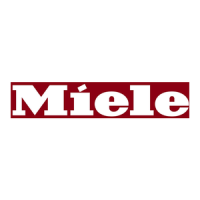

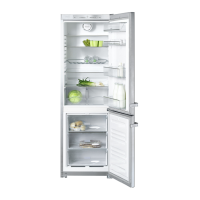
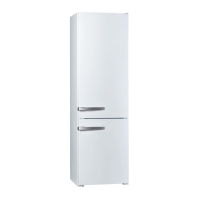



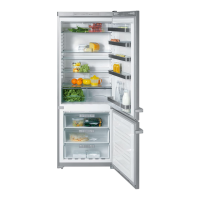

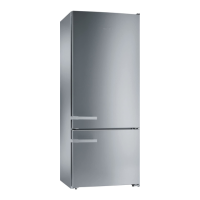
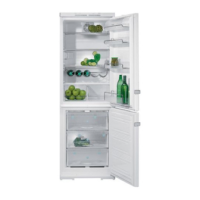

